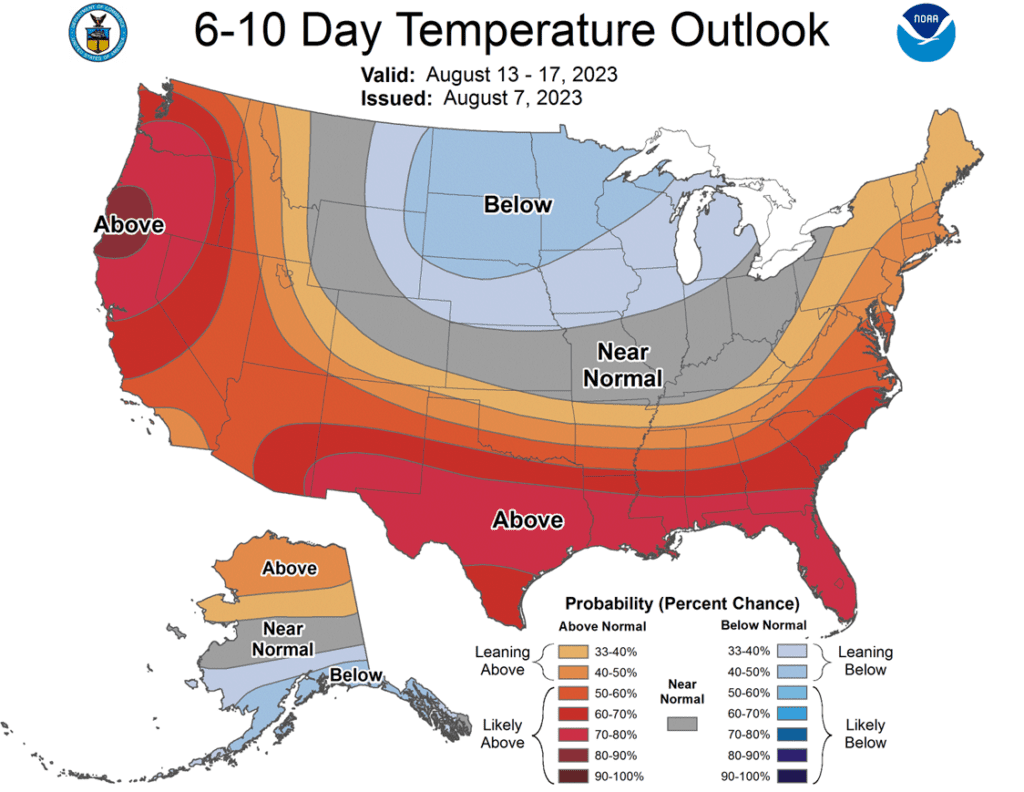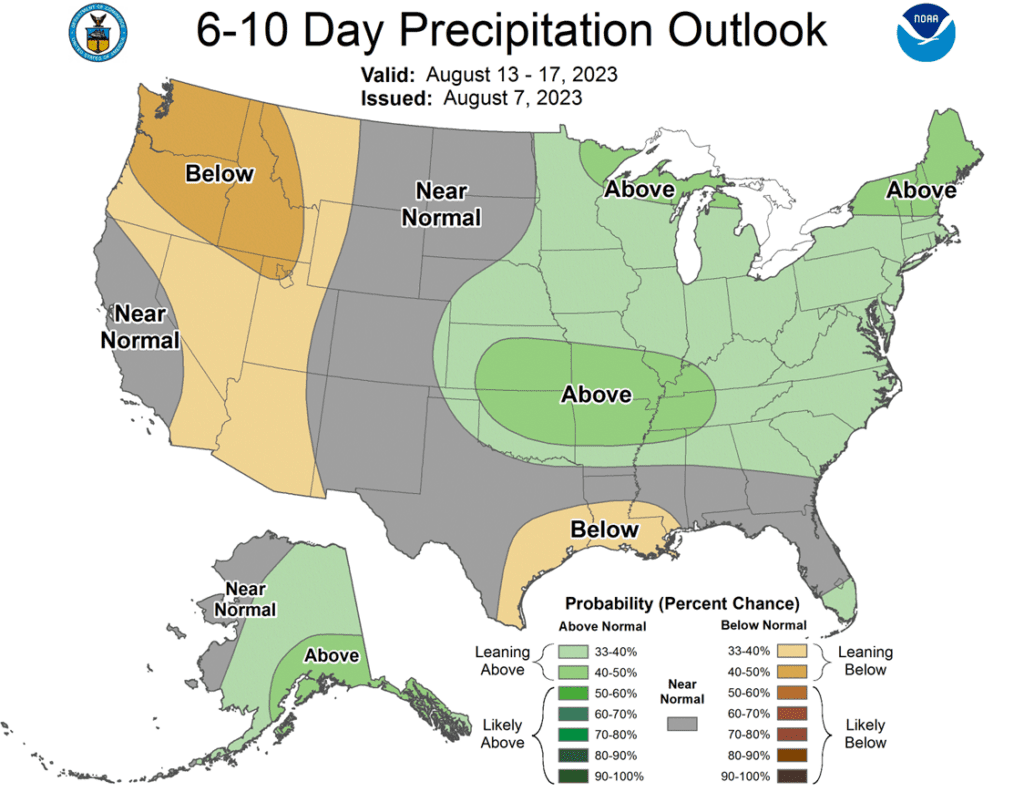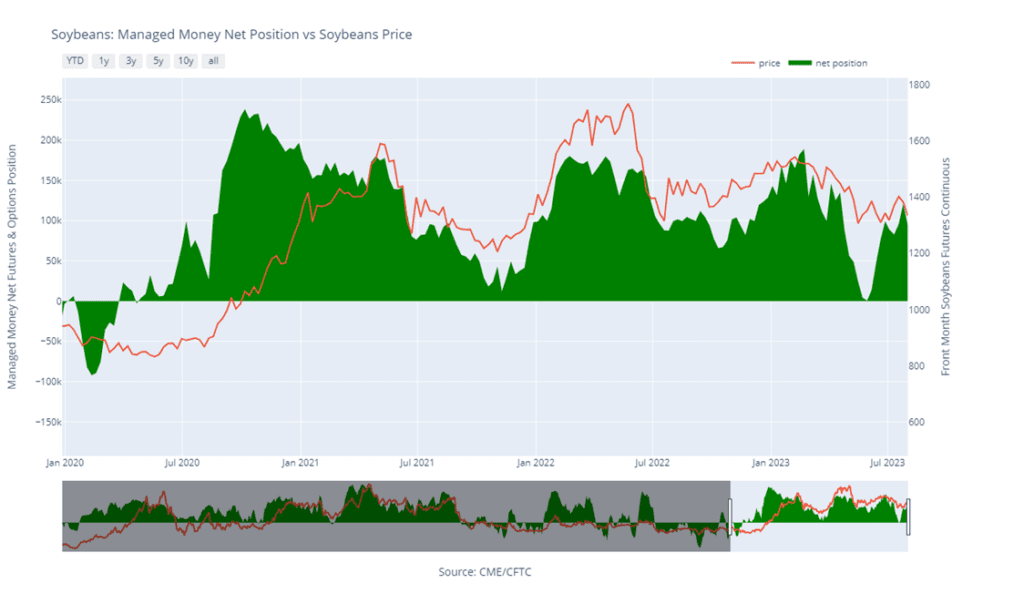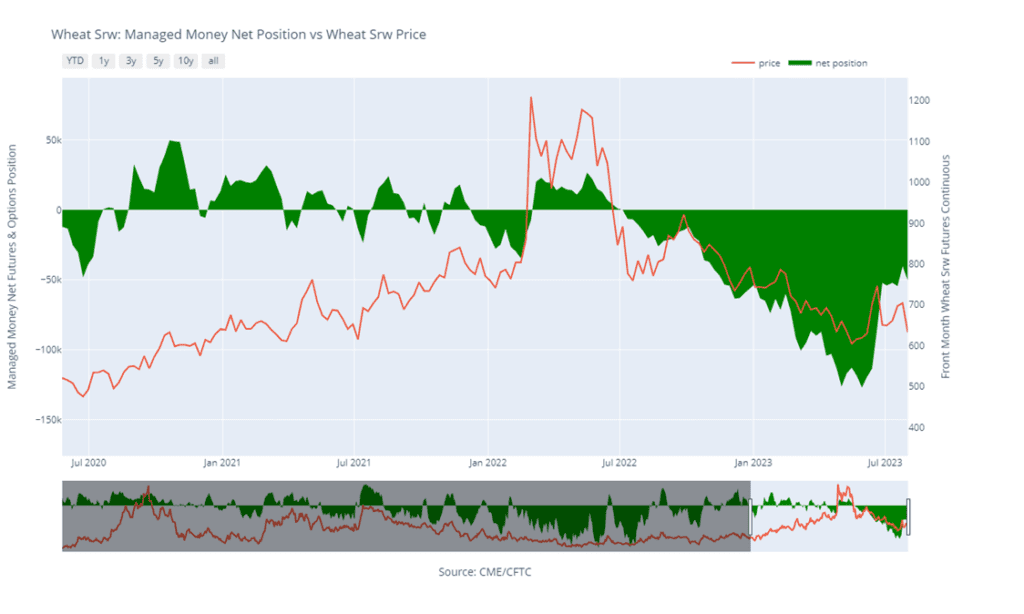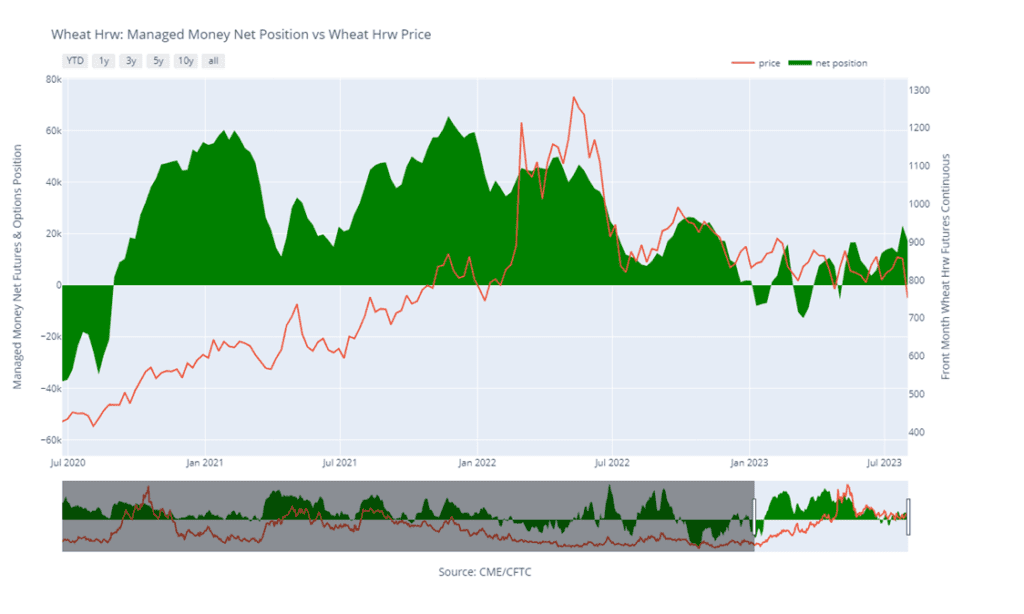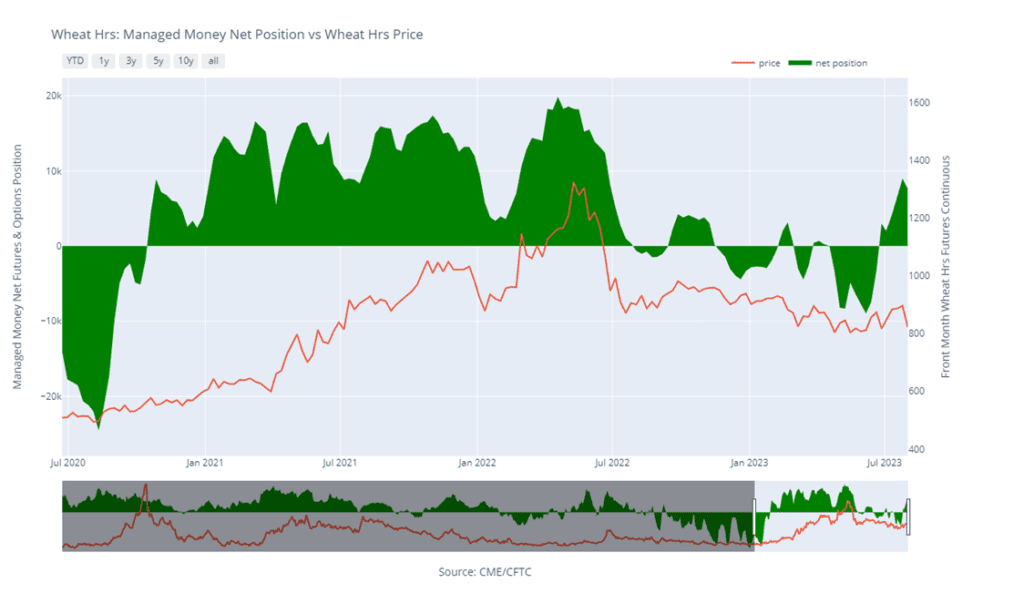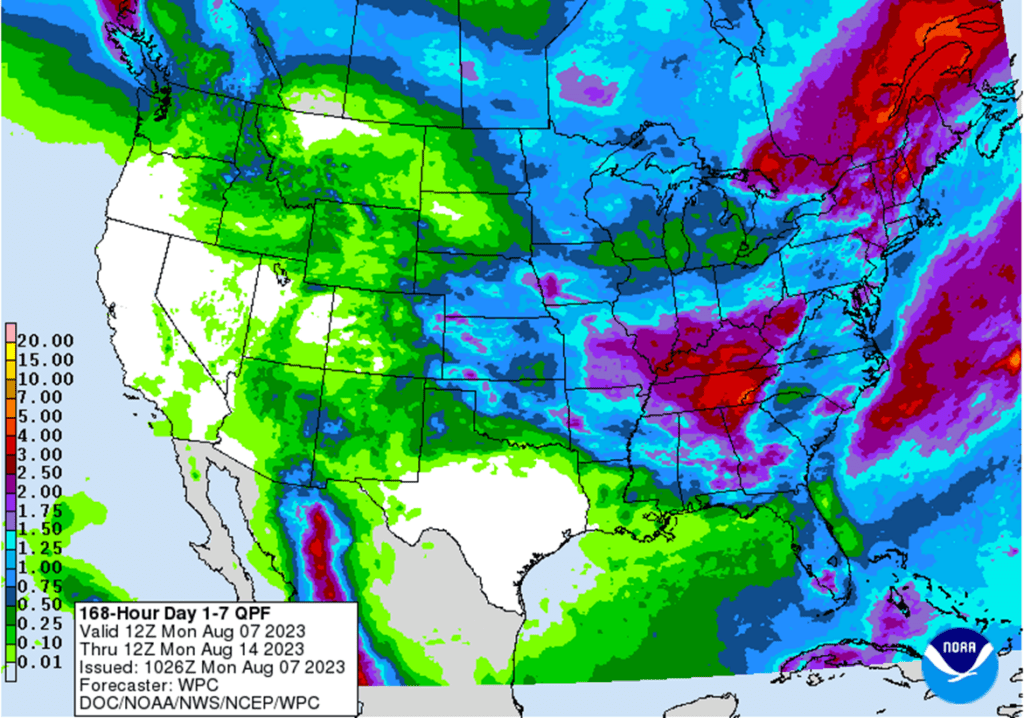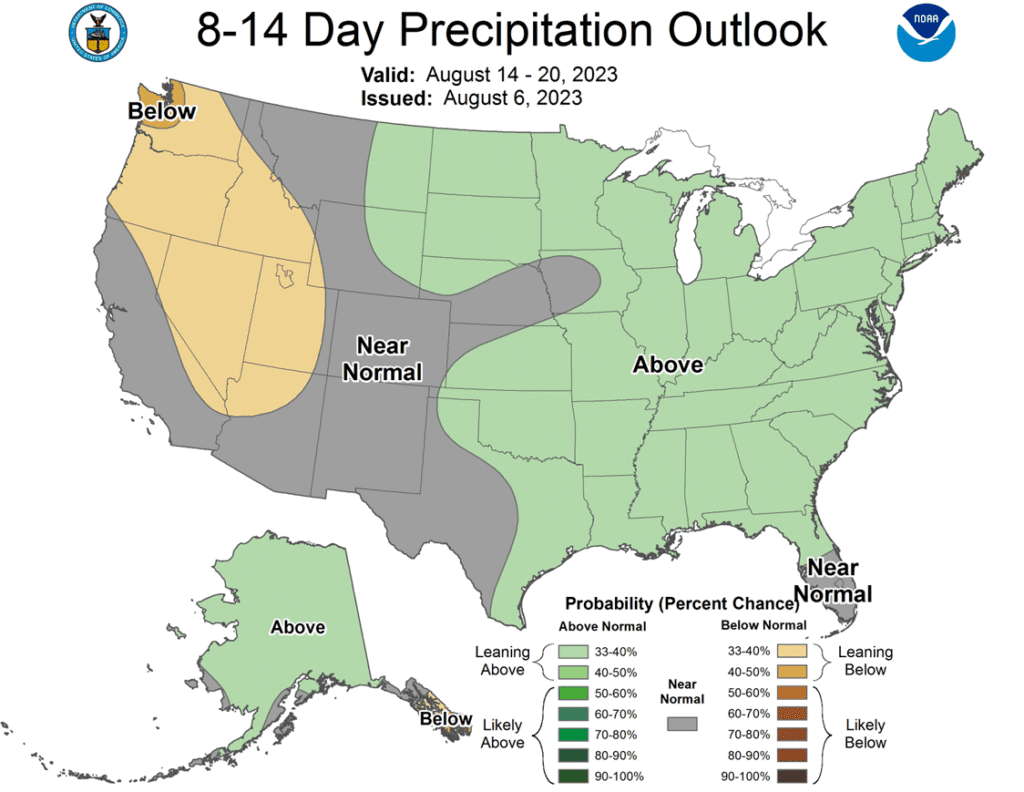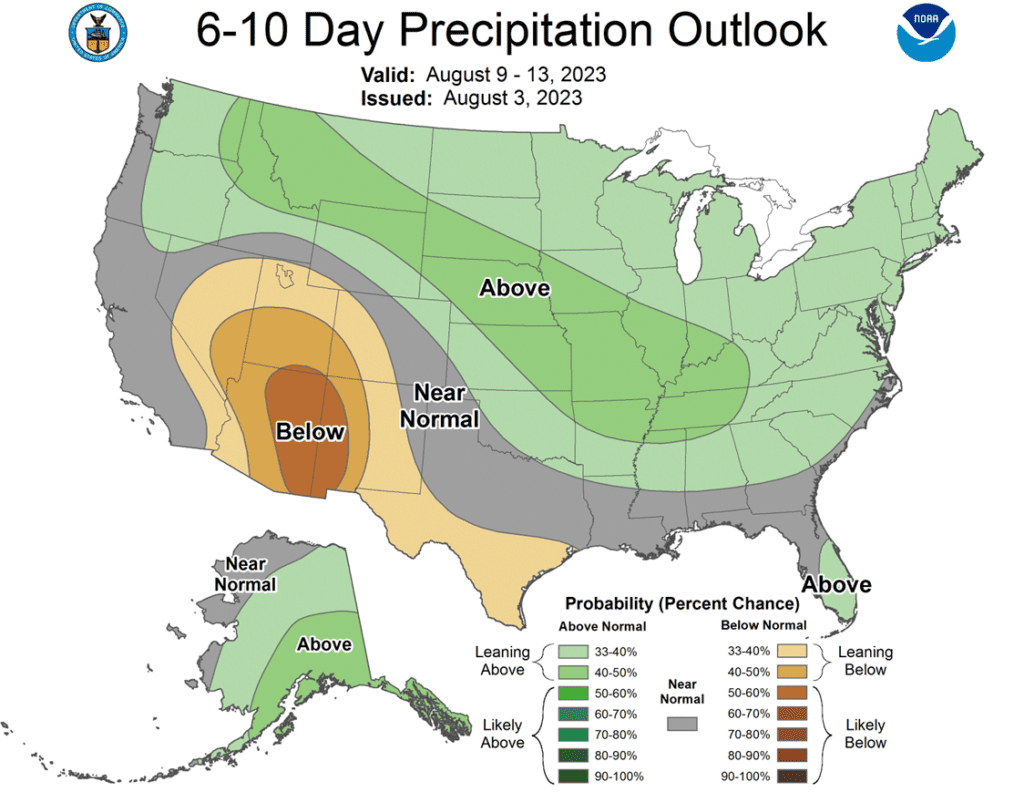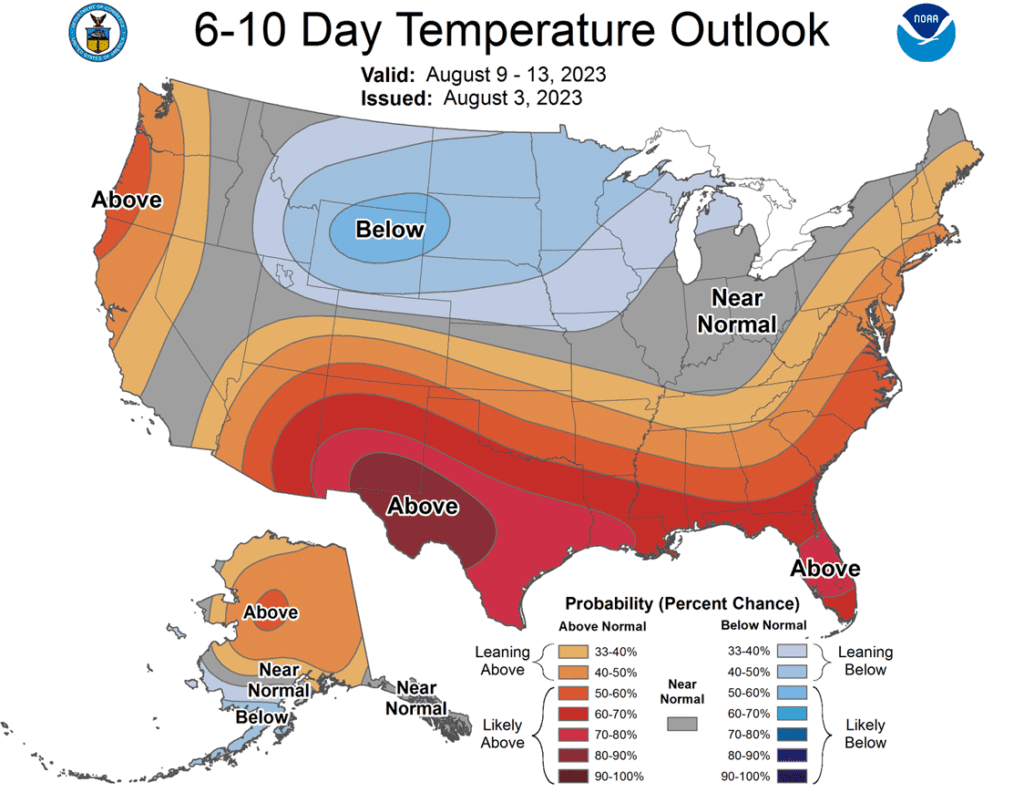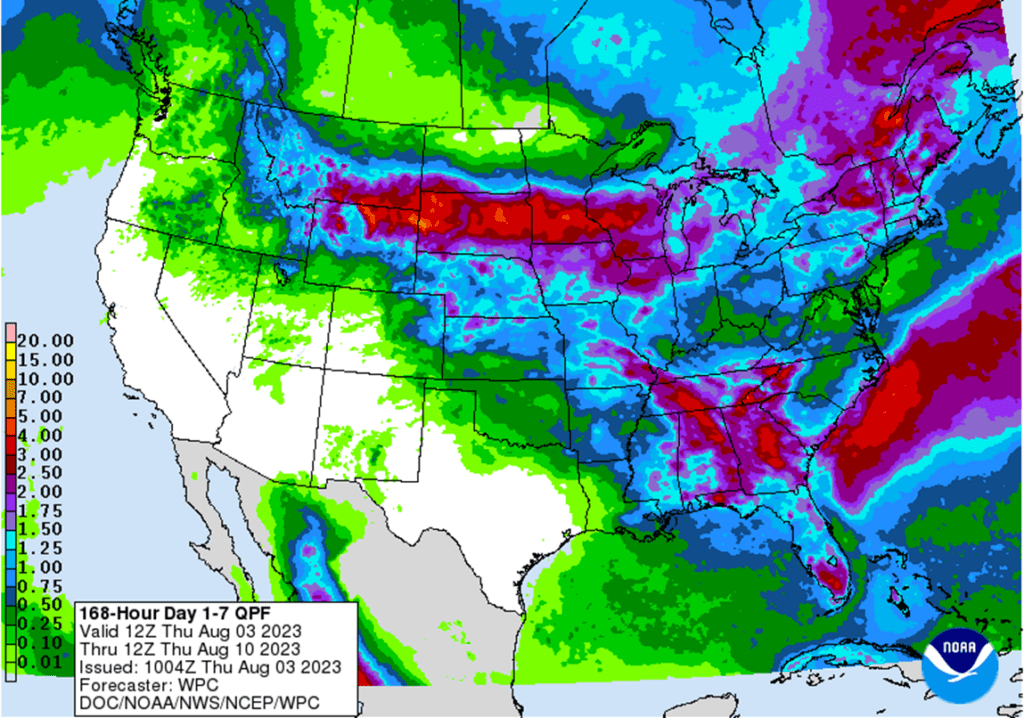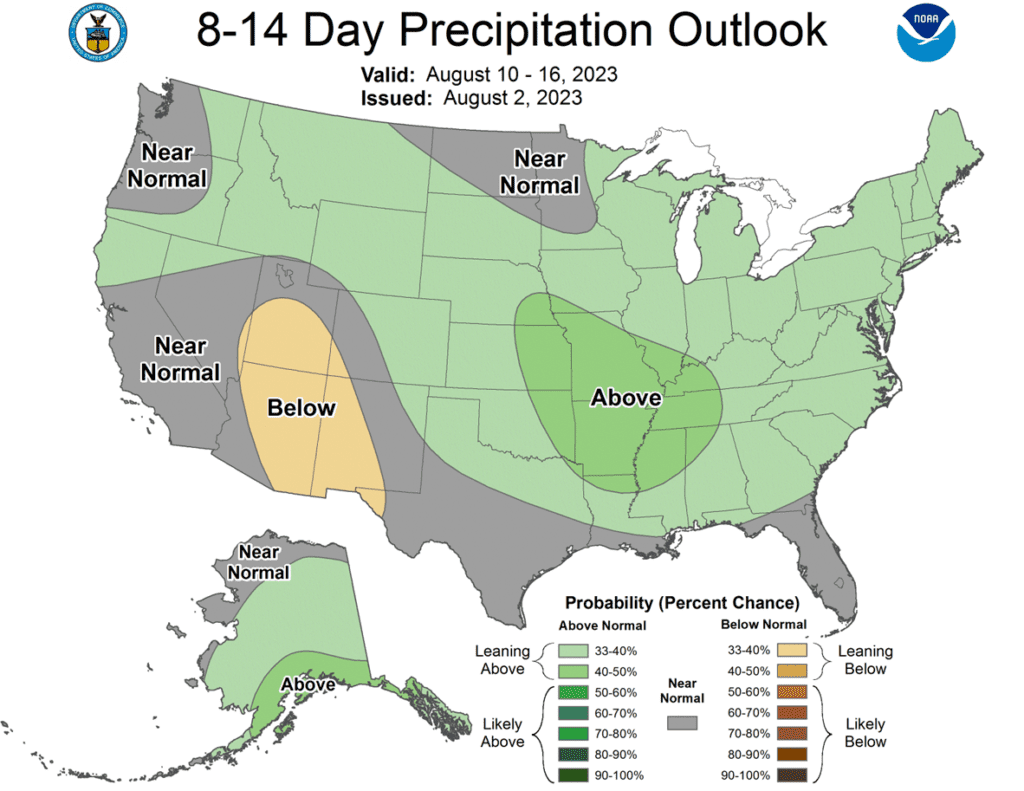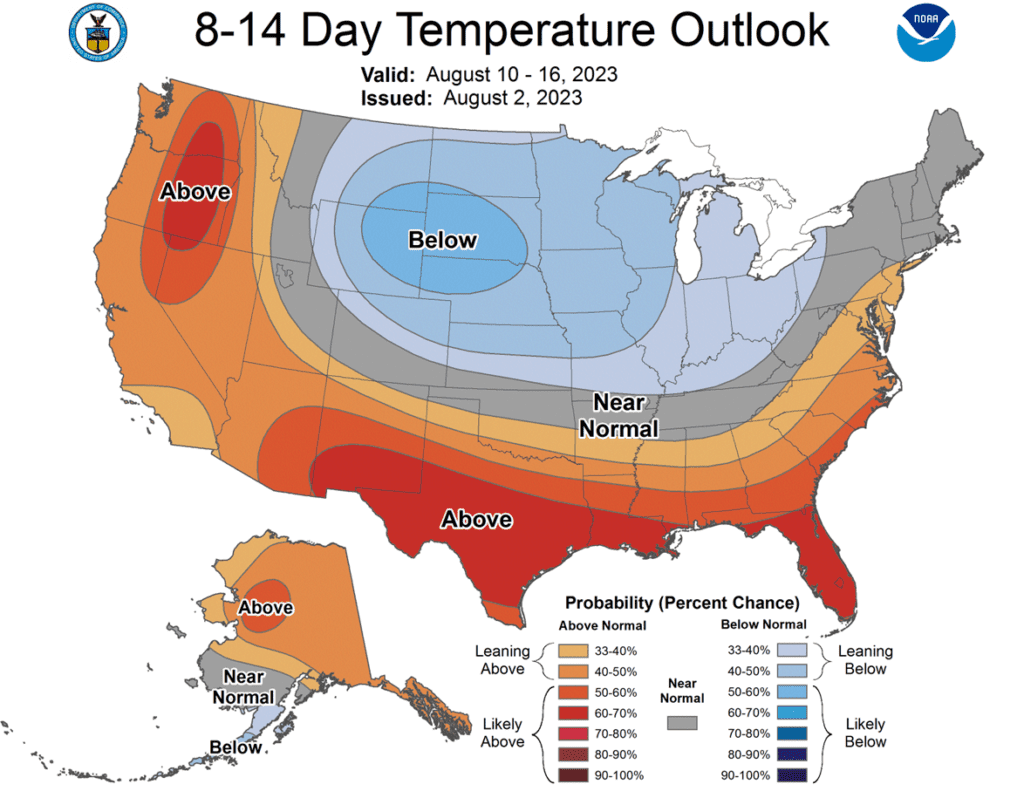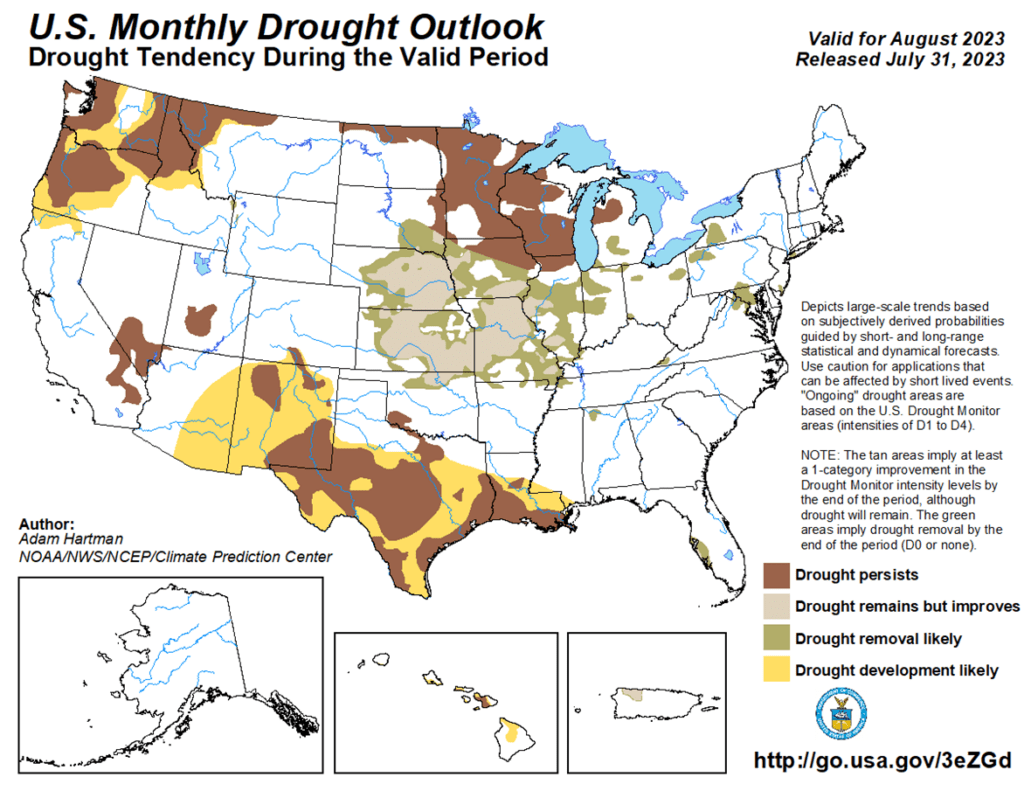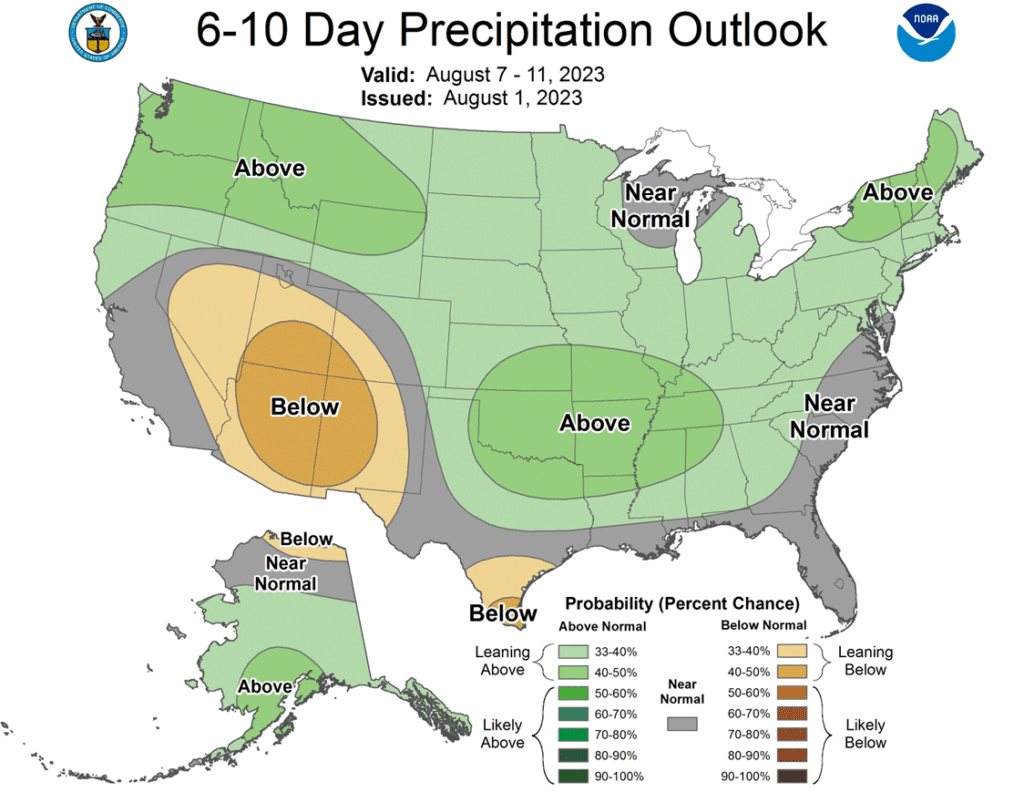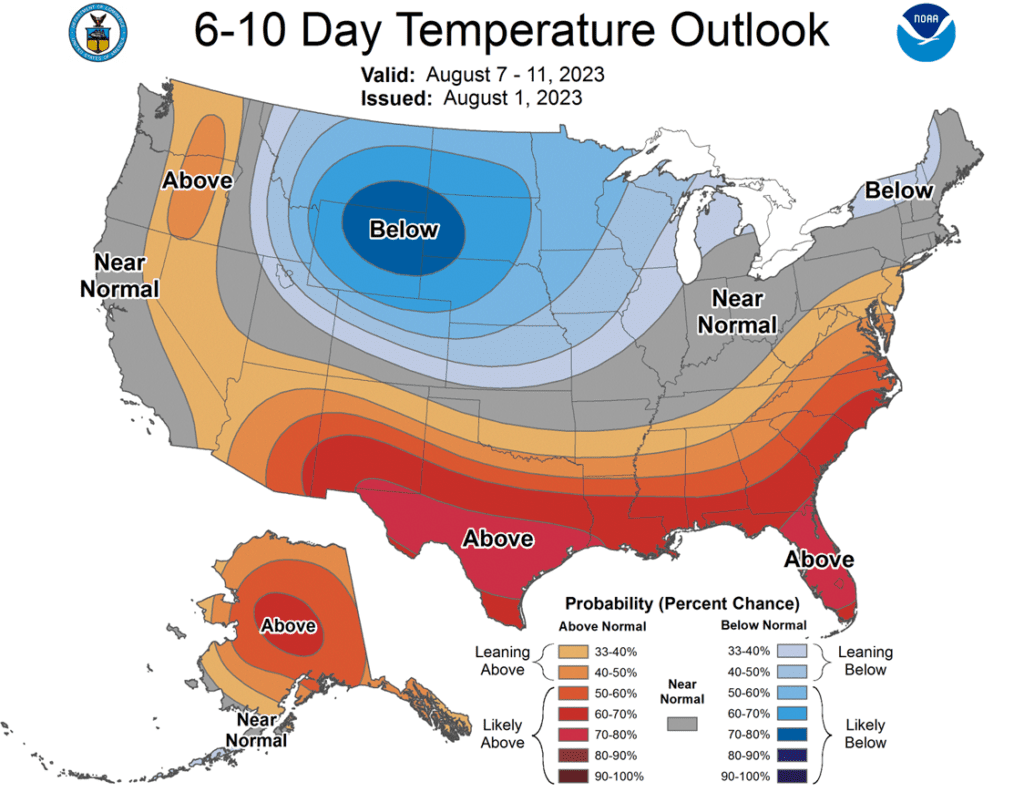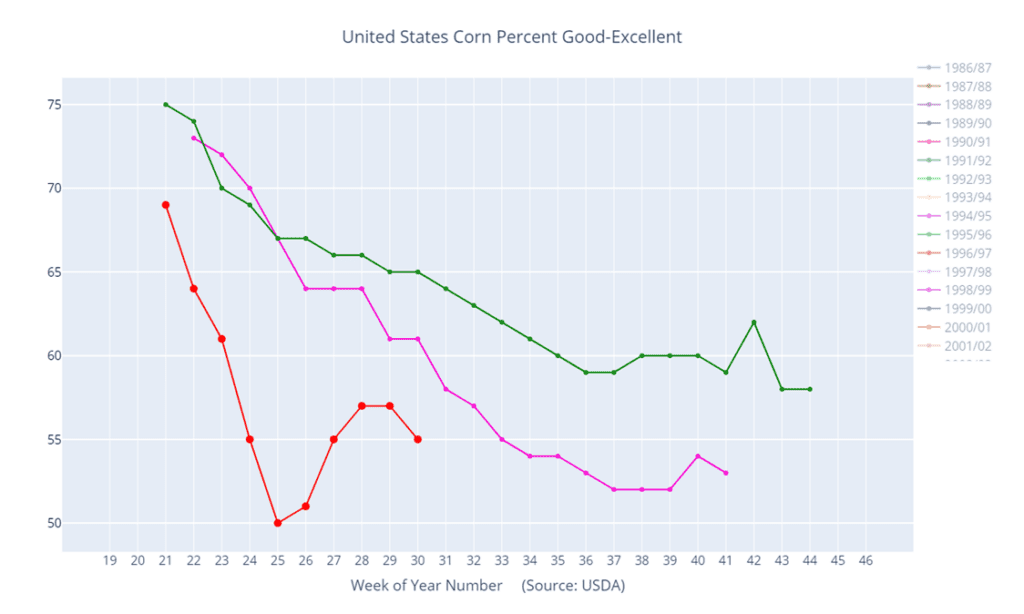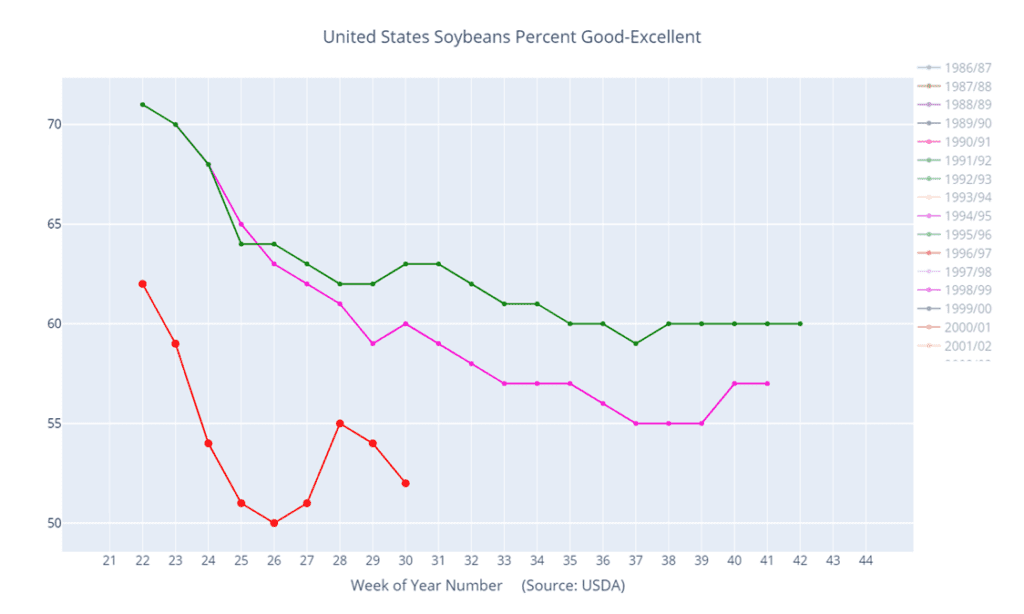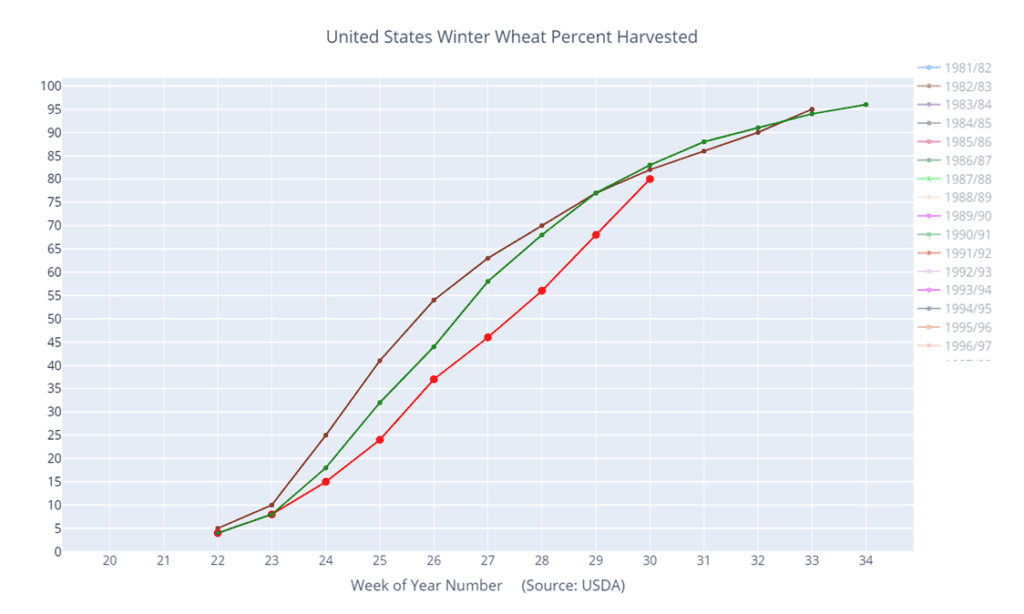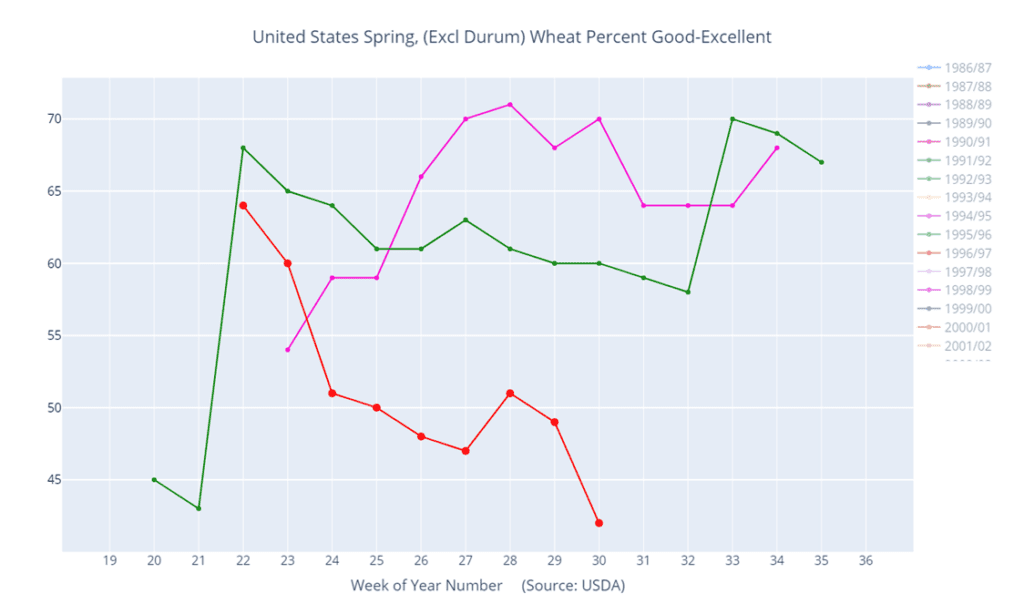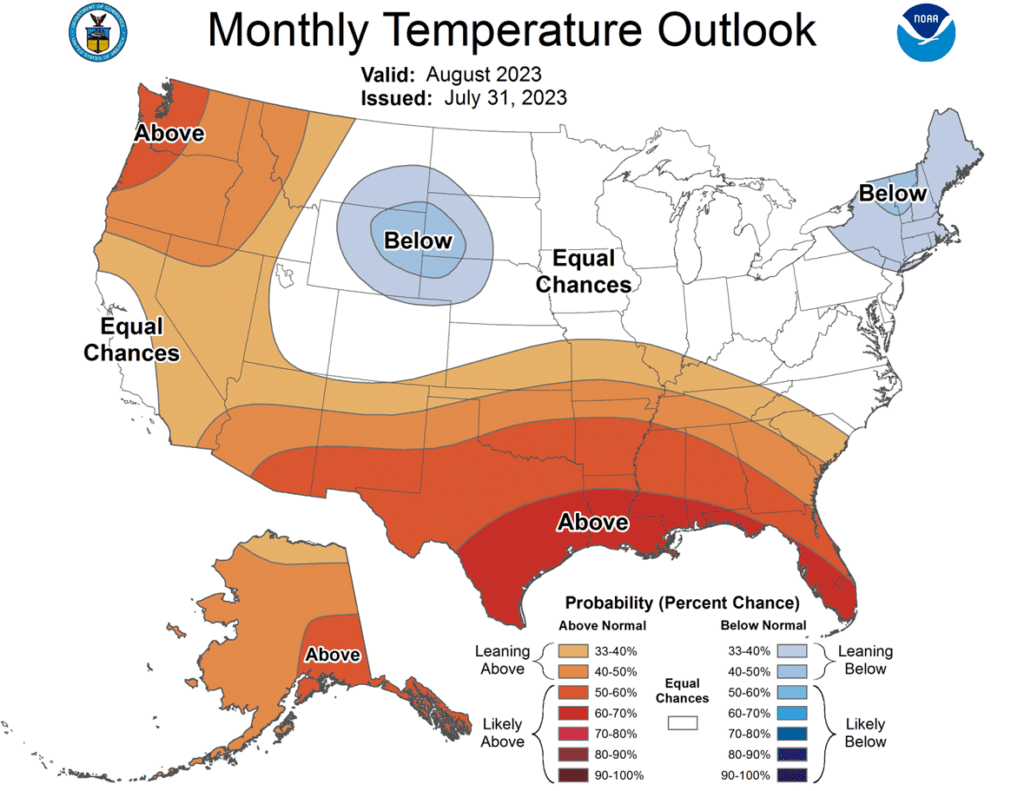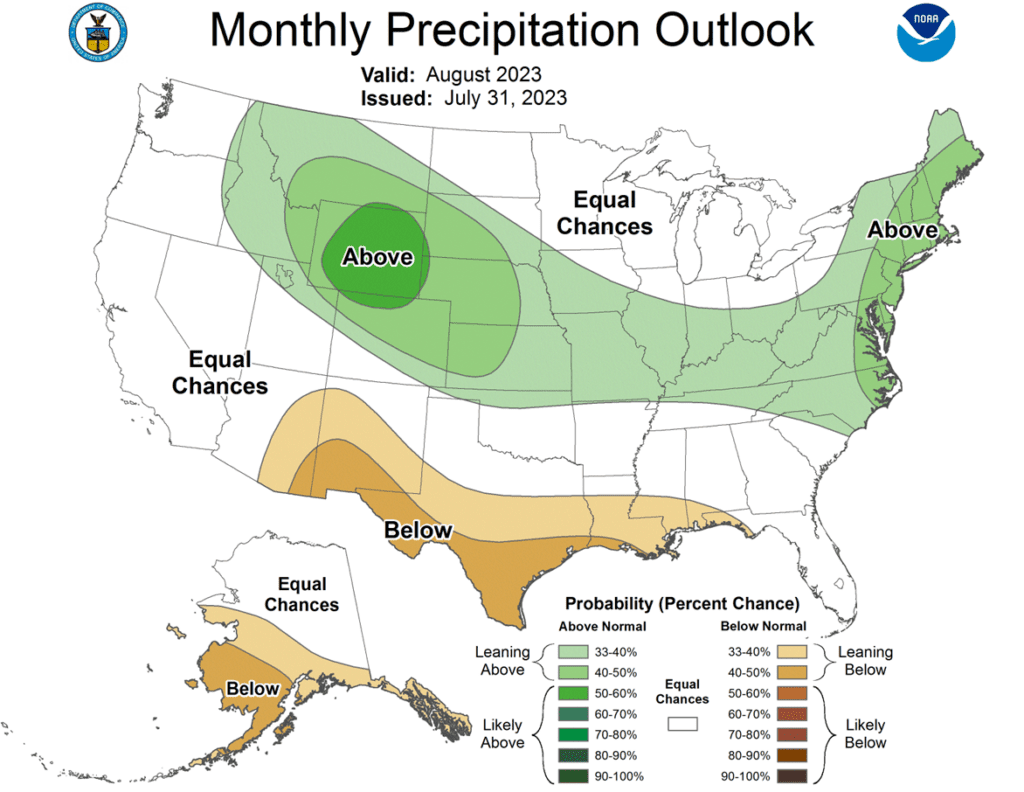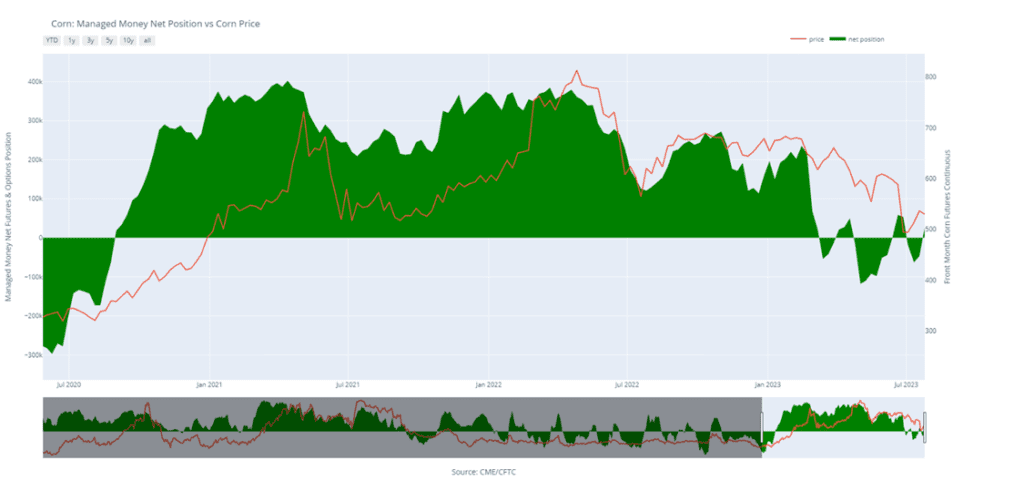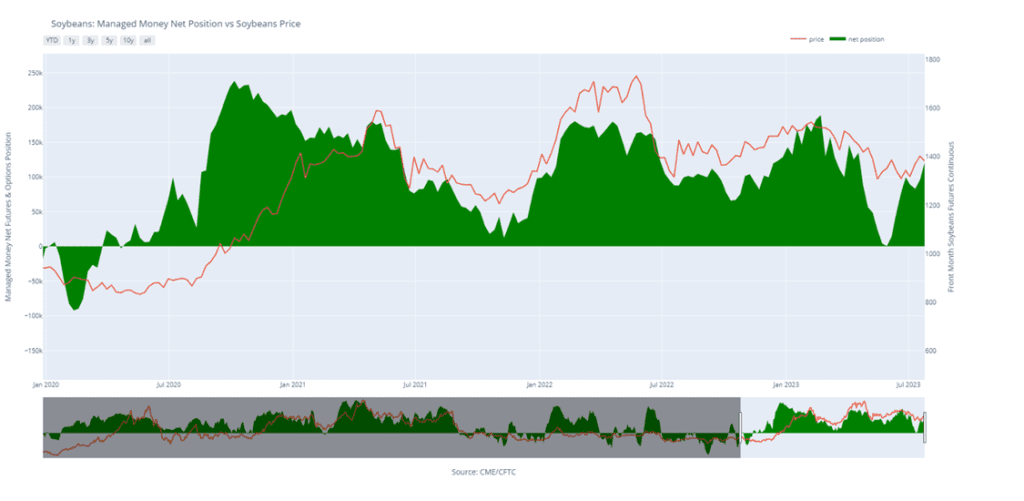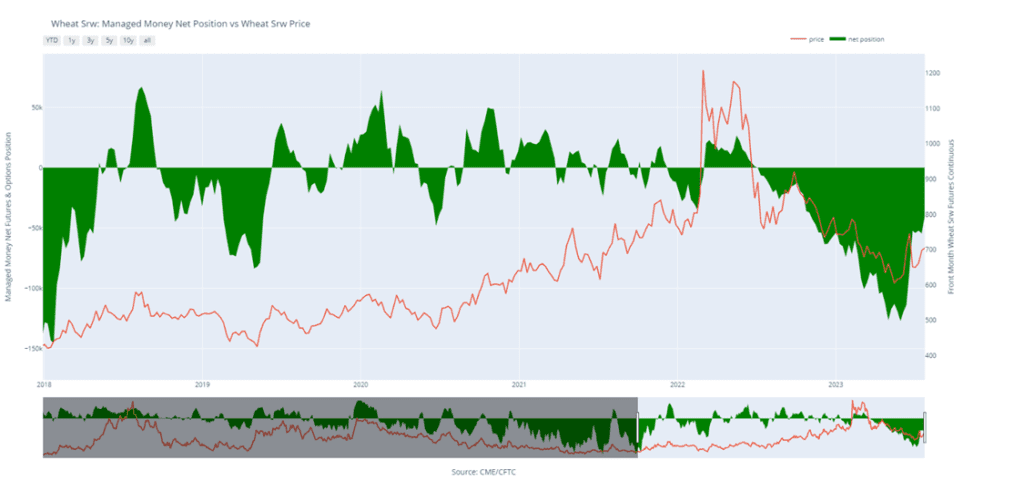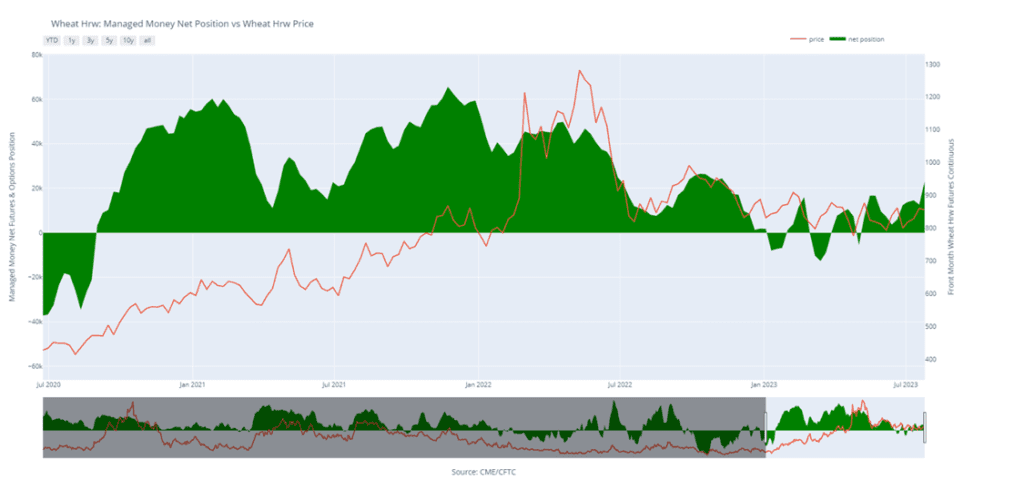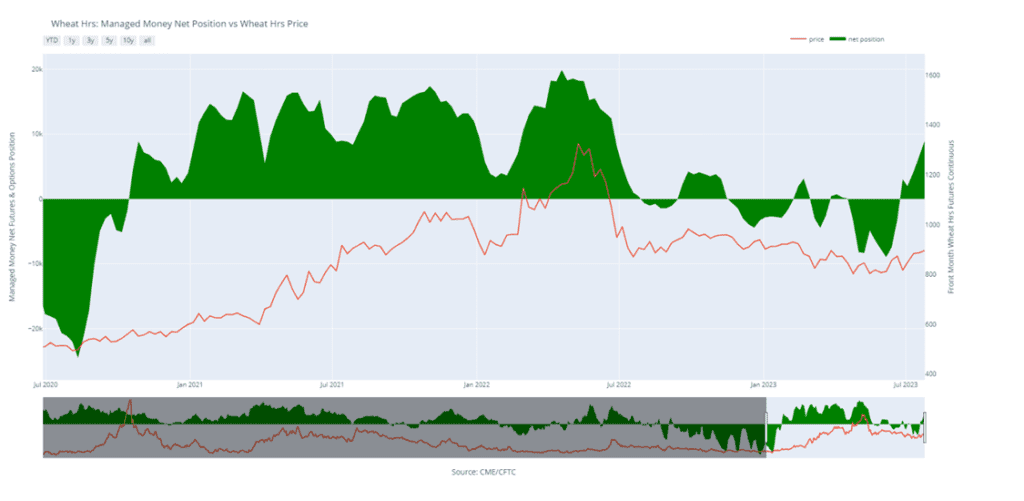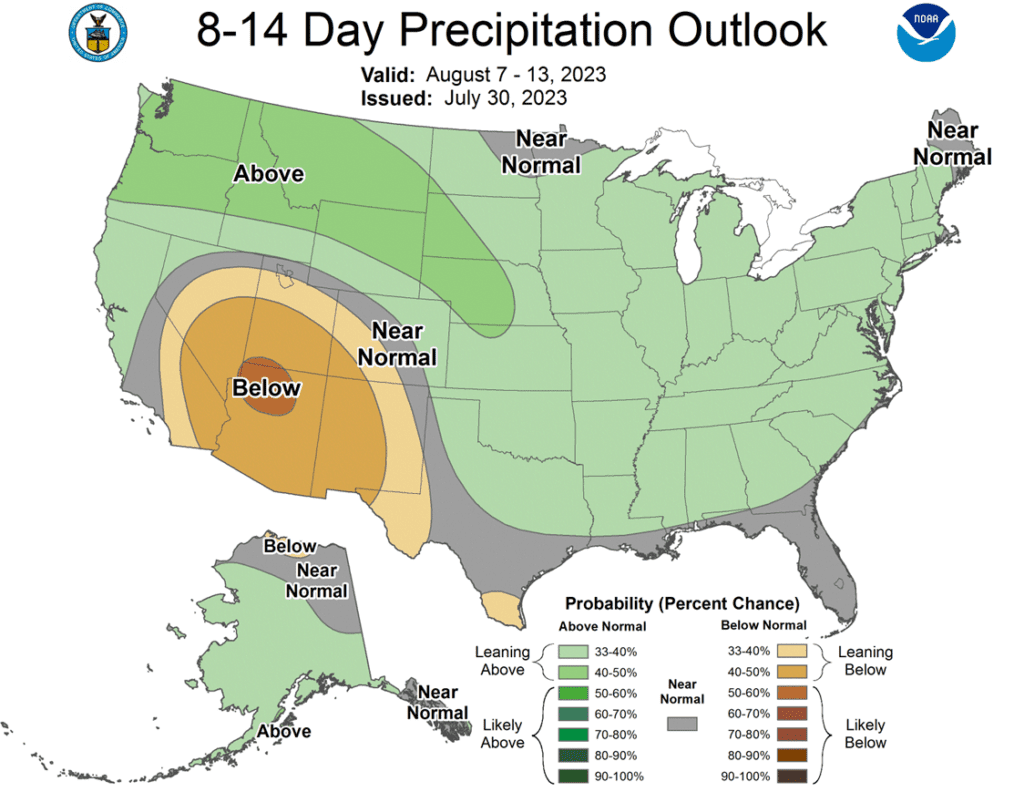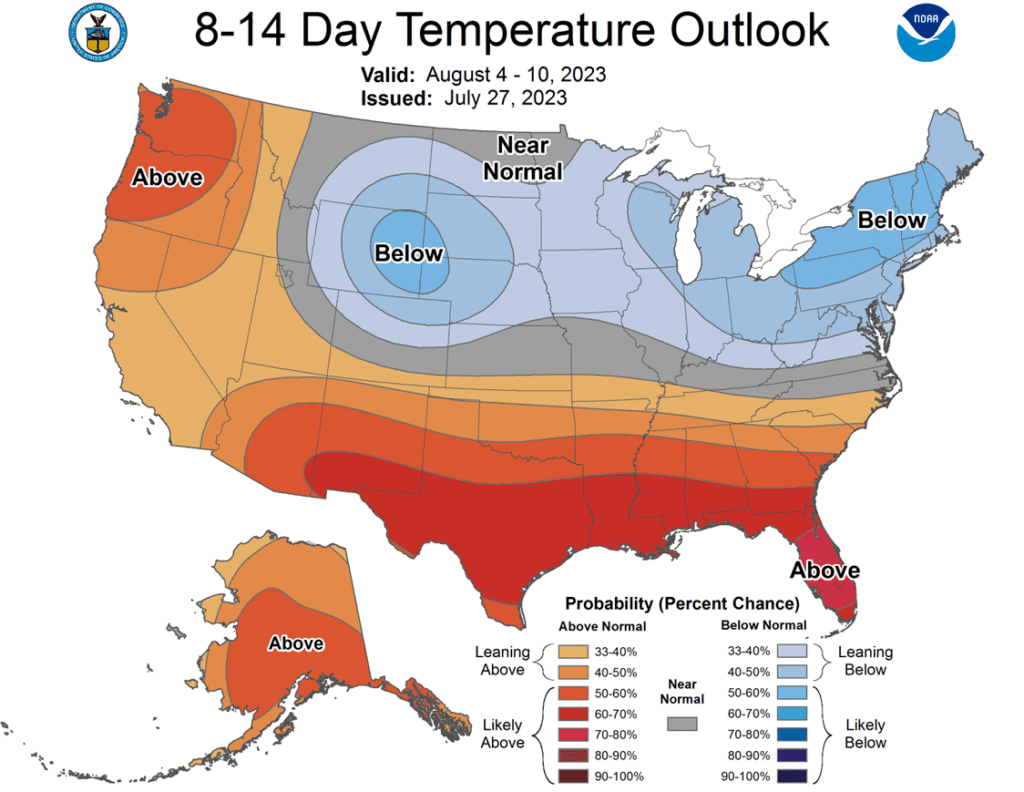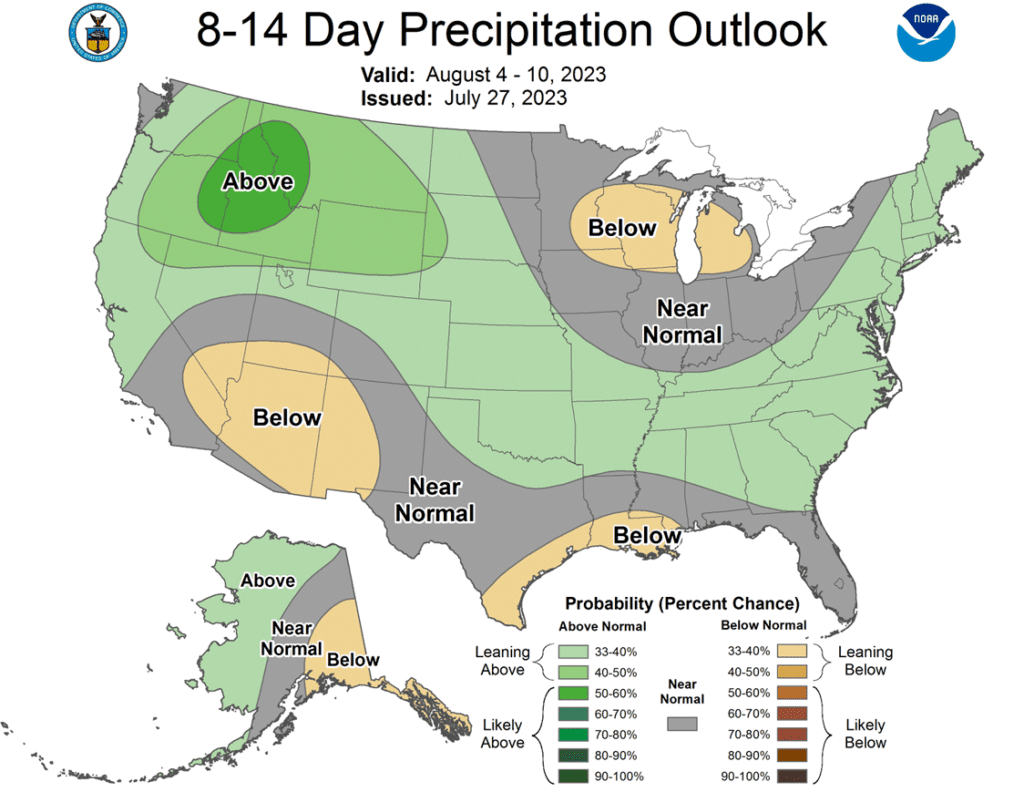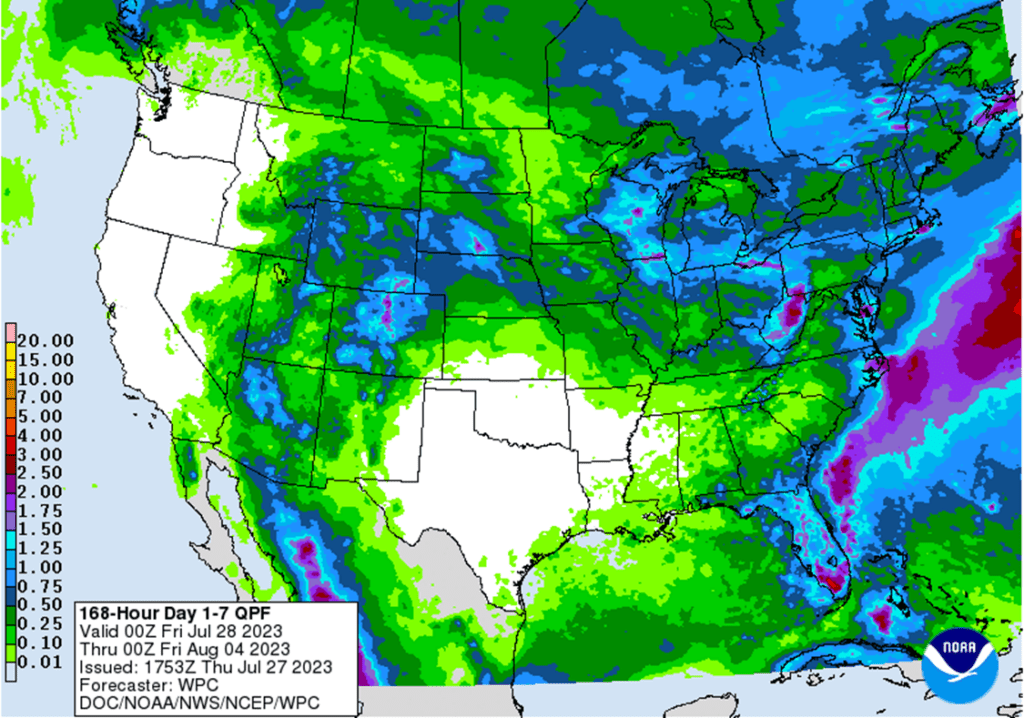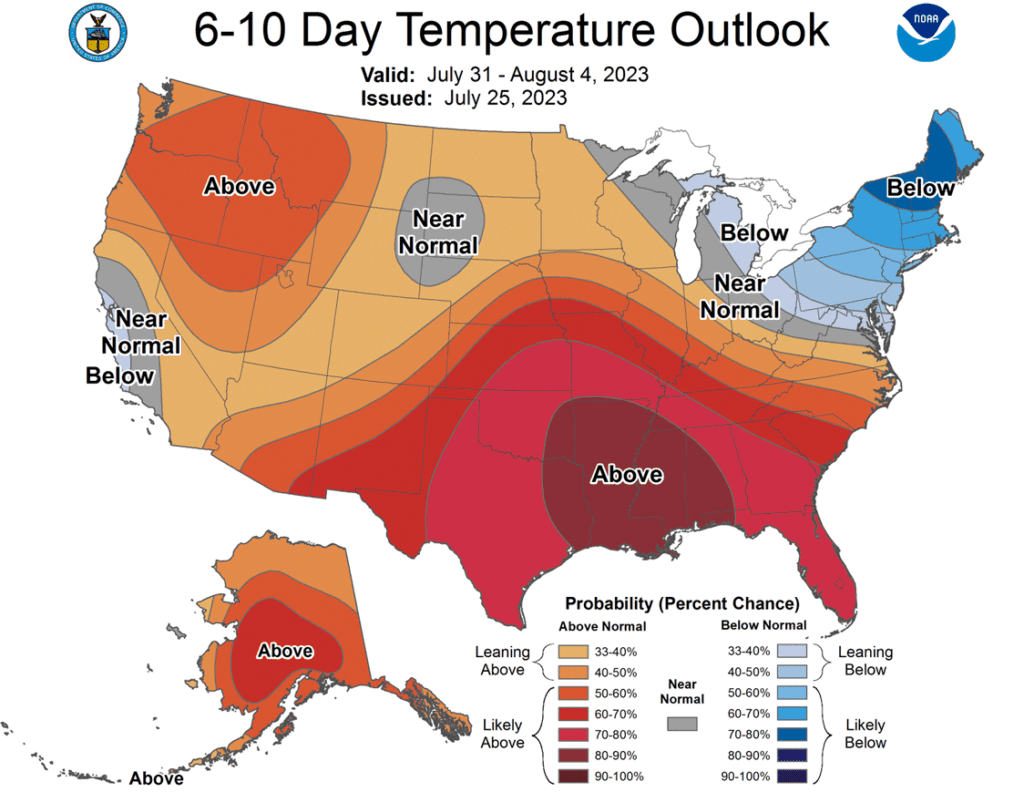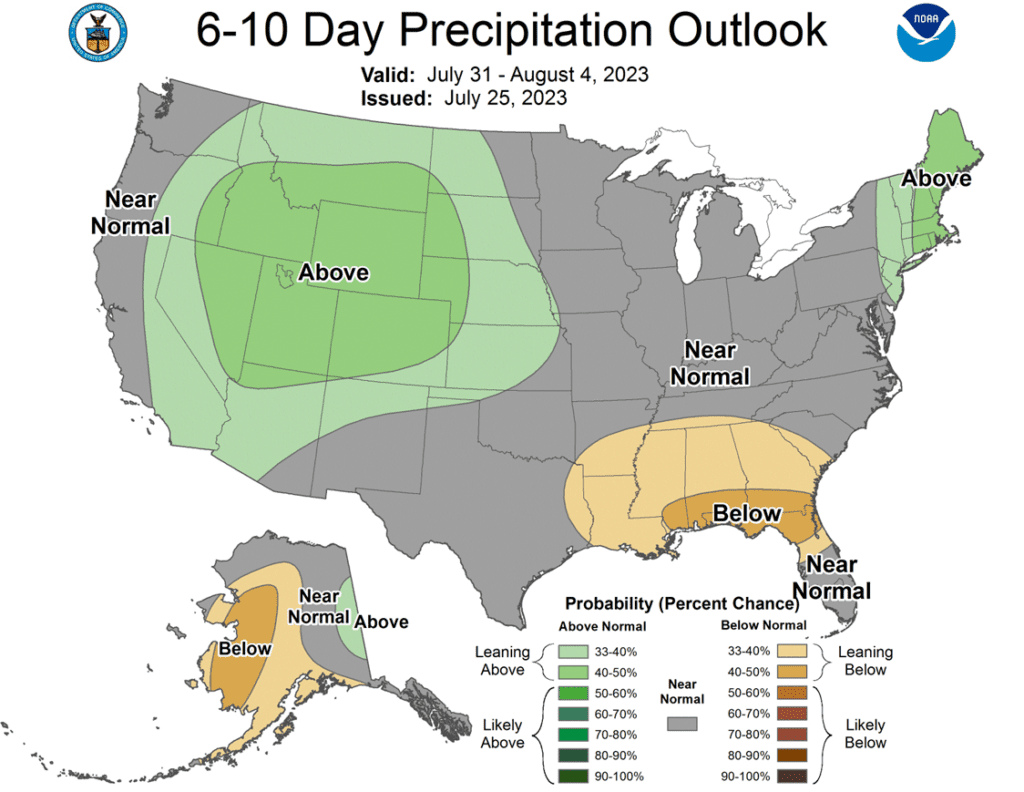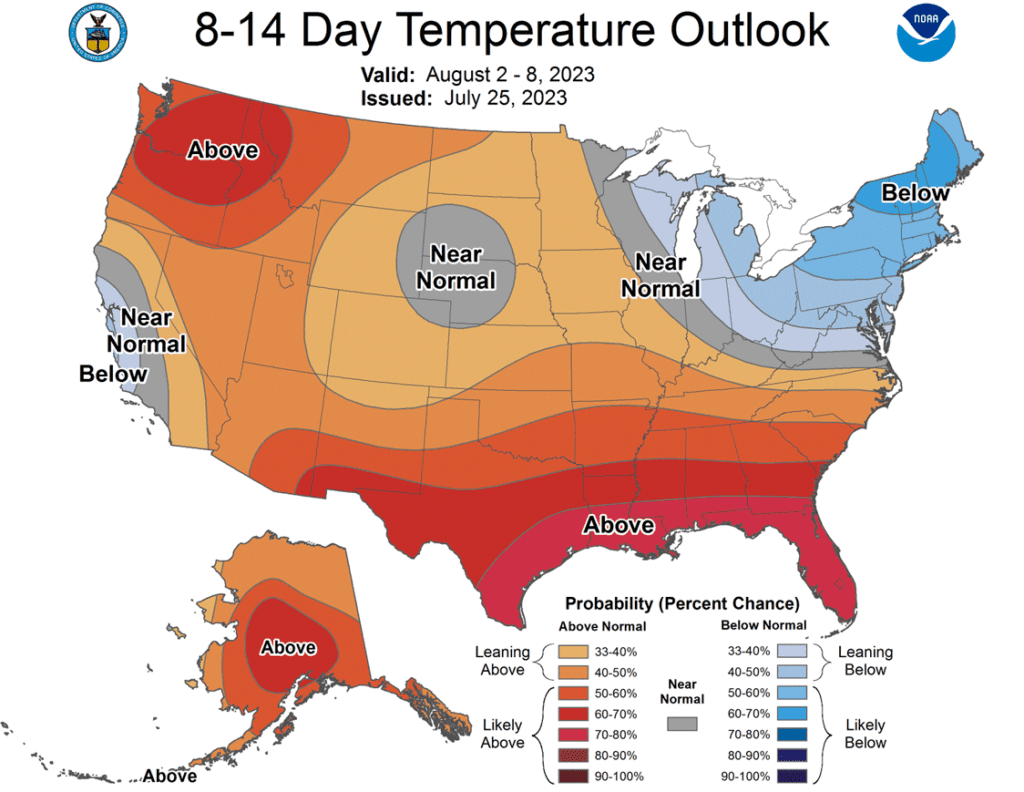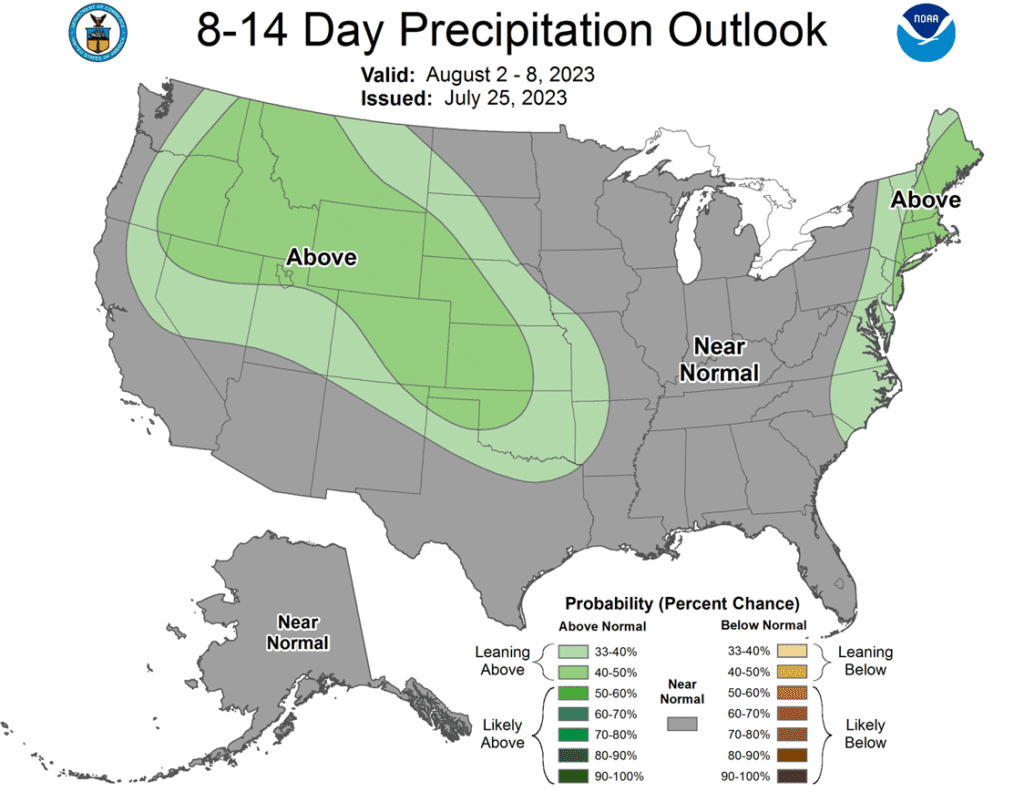Grain Market Insider: August 8, 2023
All prices as of 1:45 pm Central Time
Grain Market Highlights
- A lack of fresh headline news from the Black Sea or word of new export sales kept the corn market in consolidation mode as traders began to even up positions ahead of Friday’s USDA report, which left the market to close in the upper part of the trading range.
- Despite the favorable weather forecasts and improving crop conditions, November soybeans reversed to close higher after trading nearly 20 cents lower on the day and testing the 100-day moving average.
- The wheat market was able to shake off earlier losses with Minneapolis leading the way higher, as crop conditions for spring wheat dropped 1% from last week, while two-sided trade led to a mixed close in the Chicago and KC contracts with Chicago contracts mostly higher and KC mostly lower, with relatively minor losses.
- There were reports of downgrades for ten US banks that weighed on the equity markets, which could have also carried over to the commodity sector with less appetite for risk. Additionally, import/export data out of China was lower than expected, possibly adding some resistance to commodities.
- To see the current US 6 – 10-day Temperature and Precipitation Outlooks courtesy of the Climate Prediction Center, scroll down to the other Charts/Weather Section.
Note – For the best viewing experience, some Grain Market Insider content is best viewed with your phone held horizontally.
Corn
Corn Action Plan Summary
- For the 2023 corn crop, Grain Market Insider sees an active opportunity to sell half of the previously recommended DEC ‘23 580 puts. At the end of June, Insider recommended buying DEC ’23 580 puts for approximately 30 cents in premium, plus fees and commission. At the time, the US Drought Monitor was showing dryness across the Midwest and weather forecasts were calling for hot and dry conditions. Since then, forecasts have turned more favorable and DEC ’23 corn has dropped over 100 cents, with the recommended 580 puts gaining nearly 200% in value. The growing season isn’t over yet, and the Drought Monitor still shows dry conditions. Following the recent market drop and pick up in export sales, any further yield loss could rally prices. Insider recommends selling half of the previously recommended DEC ’23 580 puts to lock in gains in case prices rally back and holding the remainder, which will continue to protect any unsold bushels if prices erode further going into harvest.
- No action is recommended for New Crop 2023 corn. The future price potential for Dec 23 corn continues to be at the mercy of each new weather forecast. Dryness and dry weather forecasts pushed Dec corn from the May low to the June high with a gain of 137 cents, which was promptly erased and then some by mid-July, leaving the market 149 cents off that June high, with a surprise jump in acres and more favorable forecasts. During the runup in early June, we warned that any change in the forecast to wetter weather could erase all the gains as corn didn’t have much of a bullish fundamental story without a supply side shock fueled by lower yields. Overall, our thought process has not changed from a month ago and with the tremendous uncertainty, and subsequent volatility still in front of us, we continue to recommend holding the Strangle options position, comprised of the previously bought Dec 610 calls and Dec 580 puts. A turn back to wetter weather and we wouldn’t be surprised to see sub-500 corn again, and if dry weather persists, we wouldn’t be surprised to see corn prices north of 700. Under either of these scenarios the Strangle will benefit and doesn’t require trying to outguess the weather.
- No Action is currently recommended for 2025 corn. 2025 markets are very illiquid right now, and it may be some time before conditions are conducive to consider making any recommendations. Be patient as we monitor the markets for signs of improvement.

- The corn market traded on both sides of unchanged today to settle in the upper end of the day’s range, with no new flash export sales reported or news from the Black Sea to move the market significantly in either direction. With the USDA’s August Supply and Demand report slated for Friday, the market continues to consolidate as traders begin to square positions ahead of its release.
- The USDA raised crop condition ratings 2% from last week to 57% good to excellent. While improvements were seen in Illinois and the Dakotas, states like Kansas, Minnesota, and Michigan remain below 50% g/e.
- DTN kicked off their digital yield tour on Monday and estimated the national corn yield at 177 bpa, close to the USDA’s July yield estimate of 177.5. The tour is set to conclude on Friday with details from a different region each day.
- China’s imports and exports for the month of July fell by 12.4% and 14.5% respectively versus last year, which was faster than expected. The slowdown may indicate a slowing economy and could lead to fewer ag imports.

Above: Since mid-July, the market retraced about 62% of the prior down move, hit resistance around the 50-day moving average, and turned lower. The market is approaching oversold status on the stochastic indicator with key support near the September contract’s 474 low. If the market receives more bullish input and turns back higher, heavy resistance lies near 555 – 565.
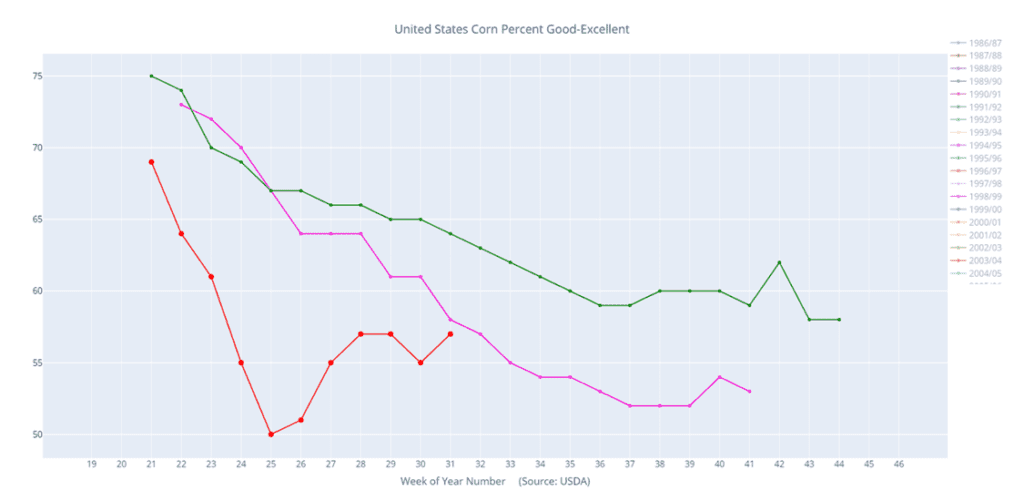
Soybeans
Soybeans Action Plan Summary
- No new action is being recommended for Old Crop. Any remaining old crop bushels should be getting priced into this rally. We won’t have any “New Alerts” for 2022 Soybeans (Cash, Calls, or Puts) as we have moved focus onto 2023 and 2024 Crop Year Opportunities.
- No action is recommended for 2023 soybeans. The USDA injected a lot of volatility into this market beginning with a much lower-than-expected planted acreage estimate, followed by a much larger-than-expected 300mb carryout estimate in its July WASDE. While demand has been weak, we have a bona fide weather market during a crucial period for soybeans and there is little wiggle room for lost yield in this year’s crop. While a drier forecast can still maintain upside potential, plenty of time remains for rain to come and push prices lower, much like in 2012, when July was dry. Then the pattern changed in August, and decent rain fell in parts of the western Corn Belt and IL, sending Nov ’12 soybeans down 20%. For now, Insider may not consider suggesting any additional sales until after harvest. Although, we will continue to monitor the market for any upside opportunities in the coming weeks.
- No Action is currently recommended for 2025 Soybeans. 2025 markets are very illiquid right now, and it may be some time before conditions are conducive to consider making any recommendations. Be patient as we monitor the markets for signs of improvement.
- Soybeans began the day lower but finished higher after trading below the 100-day moving average. Front month soybean meal ended the day lower with deferred months higher, while soybean oil was weak following a decline in palm oil.
- Lower prices earlier in the day were partially caused by weak economic data out of China that saw their July exports declining by the largest amount since February 2020. China has been an active buyer of US soybeans over the last week and another sale of 4.9 mb was announced yesterday for the 23/24 marketing year.
- Yesterday’s Crop Progress report showed soybean ratings improving after the recent rains. The good to excellent rating rose by 2 points, above the average trade guess, to 54%. Illinois showed the highest improvement with an increase of 12 points to 58% after the significant rainfall totals.
- 66% of the soybean crop is setting pods which is ahead of the 5-year average, but yield numbers are still up in the air. The USDA’s most recent estimate was 52 bpa and they will release a revised estimate in the report on Friday, while DTN’s Digital Yield Tour has pegged yields at 51 bpa.

Above: The market posted a bullish reversal on 8/08 after trading through 1350 support and trending lower since 7/27. Additionally, the fact that the market is showing signs of being oversold is supportive to prices. If prices continue to the upside, resistance can be found near 1400 and again around 1450. If not, support below the market may be found between 1318 and the psychological 1300 level.
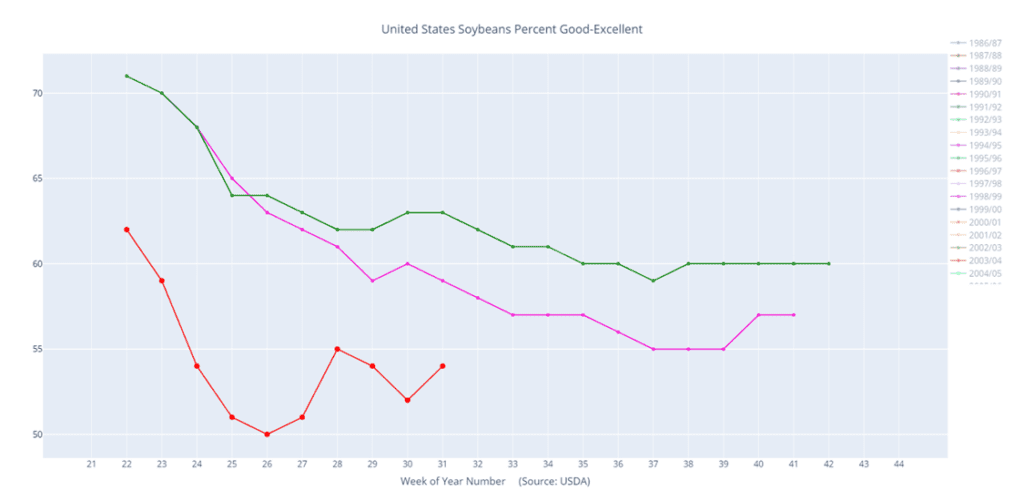
Wheat
Market Notes: Wheat
- After a two-sided trade today, wheat managed a mostly positive close. Early weakness, which affected most commodities, likely came from Chinese trade data which showed that their economic activity may be slowing. Their imports and exports in July were lower than expected.
- The USDA rated the US spring wheat crop 41% good to excellent. This is a 1% drop from last week, and it is possible the USDA will lower production in Friday’s report due to recent declines in condition.
- Though it has been mentioned before, it is worth reiterating that India’s wheat crop could be below 100 mmt. With their domestic usage usually around 108 mmt, this would reinforce the talk that they are looking to import 9 mmt of Russian wheat. Despite recent price increases, Russian wheat is still the world’s cheapest.
- SovEcon increased their estimate of Russian wheat exports for 23/24 to 48.1 mmt, an all-time high, versus 47.2 mmt previously. There is some question about the logistics though, as this assumes Russia will have no problems exporting the wheat due to the war. In addition, IKAR increased the Russian 2023 wheat crop estimate to 88 mmt (vs 86.5 mmt previously).
Chicago Wheat Action Plan Summary
- No new action is recommended for 2023 New Crop. The wheat market has seen a great amount of volatility in recent weeks and has primarily been a follower of corn, which has been driven by weather. Although demand remains weak, the closure of the Black Sea corridor, and the continued supply uncertainty, which that brings to the market, still leaves many supply questions unanswered. While Grain Market Insider will continue to monitor the downside for any violation of major support following the recent sales recommendation, it may be after harvest or near the end of summer before we consider recommending any additional sales for the 2023 crop.
- No action is currently recommended for 2024 Chicago wheat. Since the middle of June, price volatility has risen with updated USDA reports, changing weather forecasts, and current events in the Black Sea. While prices continue to be volatile, plenty of time remains to market the 2024 crop. The war continues in the Black Sea region, major exporting countries’ stocks are at 11-year lows, and no one knows what the weather will bring, leaving the market vulnerable to many uncertainties. For now, after recommending making a sale for the 2024 crop, and while keeping an eye on the market to see if any major support is broken, Grain Market Insider would need to see prices north of 800 before considering recommending any additional sales.
- No Action is currently recommended for 2025 Chicago Wheat. 2025 markets are very illiquid right now, and it may be some time before conditions are conducive to consider making any recommendations. Be patient as we monitor the markets for signs of improvement.

Above: Since testing the June high on 7/25, the market has retreated and support near 620 has held. September wheat is oversold and appears to be consolidating at the lower end of the 622 – 777 range. If the market breaks out to the downside, psychological support could be found near 600 with key support near 573, while heavy resistance remains above the market around 777 – 808.
KC Wheat Action Plan Summary
- We continue to look for better prices before making any 2023 sales. As harvest winds down and more becomes known about this year’s crop with some reports of better-than-expected yields, questions remain about the world wheat supply. The war continues in the Black Sea region, Ukraine’s export capabilities remain uncertain, and dryness continues in key production areas of the world. With world supplies currently seen at 11-year lows, we continue to target 950 – 1000 in the July futures as a potential level to suggest the next round of New Crop sales.
- No action is currently recommended for the 2024 crop. Demand and supply concerns out of the Black Sea continue to dominate the market right now, and Insider suggested making a sale as prices closed below 817 to protect from further downside erosion due to a potential change in trend with cheap supplies continuing to flow from Russia and Ukraine hampering US export demand. While prices continue to be volatile, plenty of time remains to market the 2024 crop. The war continues in the Black Sea region, major exporting countries’ stocks are at 11-year lows, and no one knows what the weather will bring, leaving the market vulnerable to many uncertainties. For now, after recommending making a sale for the 2024 crop, Grain Market Insider would need to see prices north of 850 before considering recommending any additional sales, while also keeping an eye on the market to see if any major support is broken.
- No Action is currently recommended for 2025 KC Wheat. 2025 markets are very illiquid right now, and it may be some time before conditions are conducive to consider making any recommendations. Be patient as we monitor the markets for signs of improvement.

Above: September K.C. wheat has retreated following the key reversal on 7/25 and is poised to test the 735 – 745 support area, which coincides with this year’s lows. Additionally, the market is showing signs of being oversold, and is considered supportive if prices reverse higher. If prices do reverse to the upside, overhead resistance lies near 830.
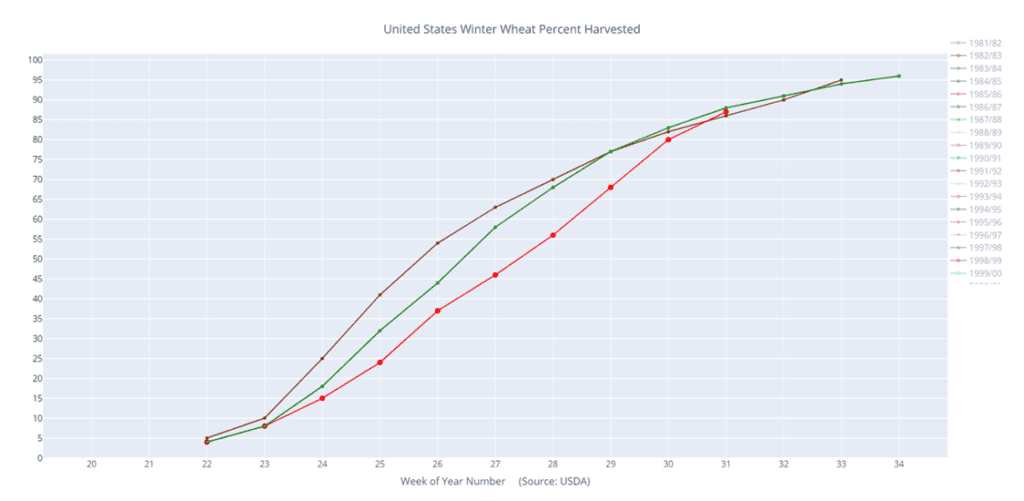
Mpls Wheat Action Plan Summary
- No action is currently recommended for the 2023 New Crop. Weather has been a dominant feature to price volatility this growing season with continued dryness concerns in not only the US, but also Canada and Australia. As we enter harvest season, there isn’t a strong likelihood of higher prices until after harvest, although both weather and geopolitical events can change suddenly to move prices higher. Insider will consider making sales suggestions if prices improve, while also continuing to watch the downside for any further violations of support.
- No action is currently recommended for the 2023 New Crop. Weather dominates the market right now, and though much of the growing season remains, Grain Market Insider suggested making a sale as prices closed below 822 to protect from further downside erosion due to a potential trend change. Seasonally, there isn’t a strong likelihood of higher prices until after harvest, although both weather and geopolitical events can change suddenly to shock the market higher. Insider will consider making sales suggestions if prices improve through this growing season, while also continuing to watch the downside for any further violations of support.
- No Action is currently recommended for the 2025 Minneapolis wheat crop. 2025 markets are very illiquid right now, and it may be some time before conditions are conducive to consider making any recommendations. Be patient as we monitor the markets for signs of improvement.

Above: Following the bearish reversal on 7/25, the market has retreated and is oversold, which could be supportive if prices reverse higher. For now, support below the market may be found near the psychological support level of 800, while resistance remains above the market near 950.
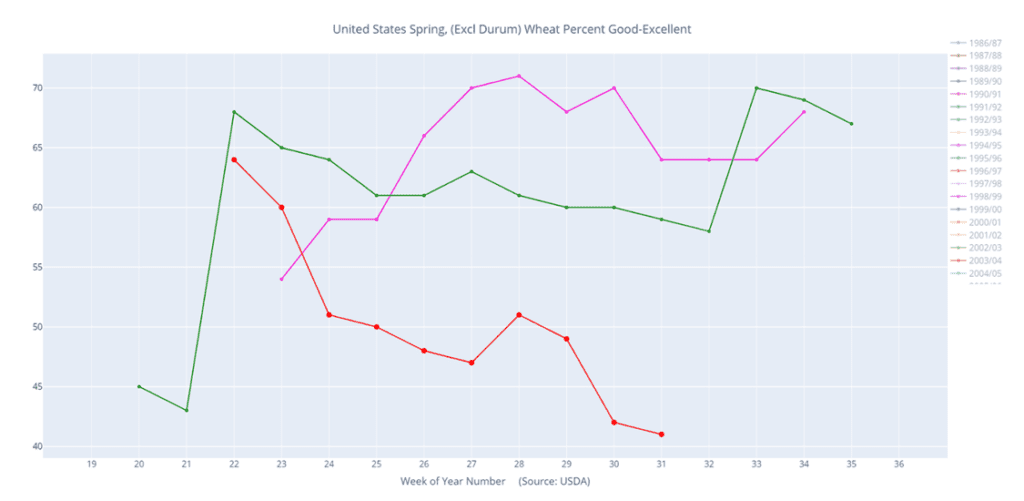
Other Charts / Weather
